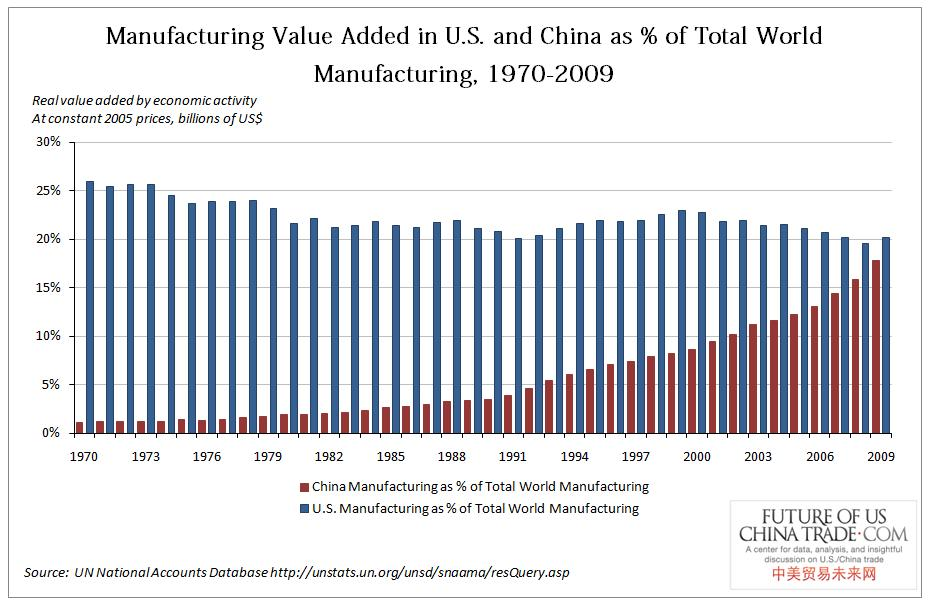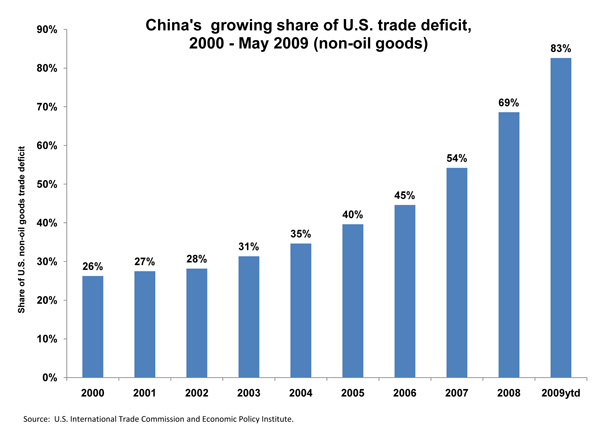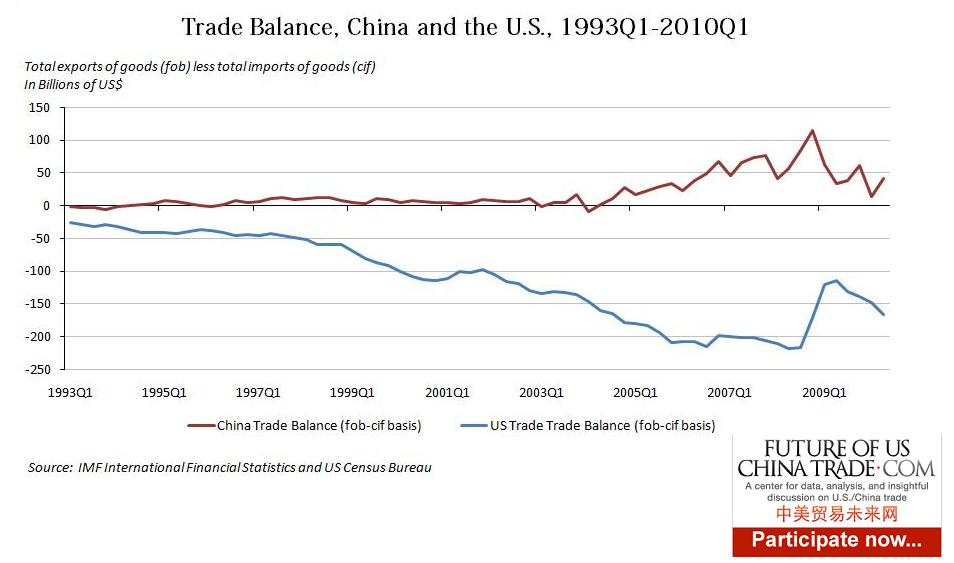Abstract
China and United States are among the largest nations on earth. China is a country found in Asia just along the Pacific Ocean and is the third largest country in the globe. Moreover, it is the most populated country in the world with over 1.3 billion people. Her land size is 3,705,407 square miles.
On the other hand, United States is a country found in the Western, Northern and Eastern hemisphere. It is slightly bigger than China with land size of 3,794,100 square miles. Additionally, it has a population of 307 million people. Despite their geographic positions, the two countries are major trade partners. Undoubtedly, international trade plays an important role in uplifting the economic standards of countries.
Different countries collaborate to create markets for the exchange of goods and services. For example, trade relationship between China and the United States of America dates back to the early days of America’s Independence. In fact, after the Second World War, China became the leading trading partner of the United States. However, upon the foundation of the Republic of China in 1949, trading activities between the two nations has had troubles.
This study examines the trade links between these two countries. Additionally, the study involves the review of trade policies, treaties, and even sanctions that enhance trade. This study reveals that, since then, trade sanctions have remained part of the US-China economic and business relations. However, the sanctions have assumed different forms on dissimilar levels of sternness and times (Louis and Bull 127).
Introduction
The United States imposed selective controls of trade with China immediately after the communist forces won the civil war in 1949. The government of United States progressively tightened export policy rules. Some years later, China entered a war with Korea forcing United States to suspend trade ties with China. In the international scene, United States has always been a major player in trade negotiations.
Thus, in order to ensure that no other country participated in trade with China, United States and other countries such as Japan and Britain created the Committee on Multinational Export Controls (COCOM). The main role of this body was to supervise the ban. In fact, by the end of 1951, there were no trade ties between United States and China.
In 1971, China recaptured its seat in the United Nations. Thereafter, President Richard Nixon made a historic visit to China. Following intense negotiations between the two nations, COCOM slackened the export controls and allowed China to get equal treatment like the Soviet Union.
Subsequently, this forced the US to permit its populace to make purchases from the Republic of China and compensate them in dollars. Since then, the total trade volumes between the two nations expanded from zero to nearly $2.4 billion in the late 1970s. This is the year when the two countries formally established diplomatic relations and signed the Trade Relation Agreement (Lehmann and Lehmann 158).
This study reveals that this was just the begging of the numerous trade agreements that followed in the subsequent years. Some of them included Agreement on Civil Aviation and Sea Transportation and the Agreement on Avoidance of Double Taxation. In addition, the two countries formed three joint committees on commerce, science, technology, and economic affairs to manage trade relations between the two countries.
By 1988, China’s exports had reached over $40 billion and the total trade topped to 480 billion dollars. However, one year later, US suspended its trade engagements with China following the Tiananmen Square incident. Other sanctions included a deferral of authorized and military interactions between the two nations, a ban on the US trade financing and investment insurance for China projects.
Additionally, United States imposed a ban on export of military and police equipments to China. On realizing this, China resorted to open door policies to enable it become significant in international markets. For instance, she took apt measures to move state owned businesses towards a market economy in order to encourage foreign investment from other countries. Surprisingly, China’s international trade continued to grow (Table 3).
In February 25, 1995, following intense negotiations, the two countries signed an IPR enforcement agreement. The main role of this agreement was to address intellectual property rights and trademarks.
In addition, this agreement increased market entrance for products based on intellectual assets. In 1949, China also became a member of the General Agreement on Tariffs and Trade (GATT) and World Trade Organisations (WTO). Sadly, the following year, China lost its membership in the two organisations and stayed in the cold for 36 years.
Again, China embarked on a strenuous road of negotiations with members allied to GATT/WTO for 15 years. However, it had to reduce tariffs and increase market access for foreign goods and services in order to become a member again. Upon admission into the WTO, China and United States entered negotiations and signed new trade agreements. Moreover, in May 2000, the American House of Representatives passed legislation that granted permanent normal trade relations with China (Halley and Wendell 130-148).
Since then, China has remained a principal trade partner of the United States. According to statistics from the US department of trade, China is the fourth largest importer of US commodities. Additionally, it is the eleventh largest purchaser of US commodities after Canada, Japan and Mexico.
For instance, in 2000, China’s exports and imports from America accounted for 2.07 % and 8.58 % of its entire exports and imports respectively. On the other hand, China has also benefitted greatly from the United States through importation of various commodities. For instance, by 2000, statistics indicates that China’s overall exports and imports to and from the United States stood at 21% and 9% respectively (Halley and Wendell 150).
Some of the key exports from China to the United States include clothing, machinery, sound and reproduction equipment, electrical machinery, apparel, footwear, games and toys. On the other hand, the exports from the US to China include transport equipment, cereal preparations, textile fibres, sound equipment, fertilizers and telecommunications.
However, the increasing USA current account deficit has become an obstacle to smooth trade between the two countries. Other factors include US’s economic sanctions on exports to China, China’s currency relocation to other countries and China’s stumpy labour cost (Table 1).
Trade Imbalance
Trade imbalance affects the smooth running of international trade. For instance, the two countries have accumulated a trade shortfall of over two hundred billion dollars. This was an increase from $162 billion from the previous year (Table 2).
Analysts blame the deficit for the loss of jobs in the US manufacturing industry. Notably, the trade imbalance emanating out of the US trade deficit is consent in disguise for China. In fact, China grows its gross domestic product through international trade. For instance, 80% of the China’s GDP comes from international trade (Halley and Wendell 146).
Despite the few done drums, experts assert that the US-China trade relationship is upright and healthy. For instance, the cheap manufactured goods from China have and keep the US inflation rate relatively low. Most importantly, this trend has reduced the burden on the poor and the middle class consumers who are key drivers of the economy. In addition, this trend has helped the US investors to make profits from their ventures, and this has facilitated the reduction of the US’s national debts (Dayer 34-76).
Currency Wars
Recently, the manner in which China treats its currency in foreign exchange markets has elicited criticism from the United States. US criticize the low valuation of the Chinese Yuan citing numerous consequences. Consequently, this makes Chinese products cheaper in America than in China. On the other hand, the US goods have become expensive in China.
Furthermore, United States critics assert that China’s defiance to play by international economic rules cripples the ability to compete on a level playing ground. For example, if China increases the value of the Yuan, United States will benefit from her exports to China. However, the main reason of controlling the appreciation of the Chinese Yuan is to promote internal interests such as controlling inflation and making Chinese firms relevant in international markets (Foot 210-214).
Protectionism
Protectionism remains an obstacle towards effective trade between United States and China. For instance, the congressional uproar in 2005 over the energy security compelled the Chinese energy company to withdraw from the deal involving controlling the shipyards lining the Panama Canal. Correspondingly, China also reacted by stopping the acquisition of the purchase of Chinese firms by firms from the United States.
Intellectual property
The respect for international property rights is definitely the principal source of anxiety between two countries’ trade relations. In fact, the constant violation of intellectual property rights and piracy are affecting the trade relationship between United States and China. In fact, counterfeit goods are dangerous to any economy. Perhaps this is the reason why very many countries continue to enact new laws to prevent piracy. However, these measures have not fully controlled this menace (Foot 219-254).
The Chinese government proposes to impose stricter and rigid IPR enforcement laws. However, the US has threatened to dispute the move by China before the WTO. Nevertheless, the move is not palatable because China might mount a vigorous arbitration procedure in order to win the challenge (Foot 198-216).
China’s plan to modernize the economy and promote indigenous innovation
China runs its trade affairs based on the National Medium and Long Term Program (NMLP) drafted by the China state council. This document undoubtedly presents an ambitious plan to modernize the structure of the China’s economy. China wants to become a global leader in manufacturing by 2050.
The plan proposes the reduction of the China’s dependence on foreign technology by 50 percent. Some of the principal objectives of NMLP by 2020 include development of science and technology hubs, reduction of public expenditure and increasing production. The document also gives priority to the development of other sectors such as aerospace, information technology and space programs.
In addition, according to NMLP document, the Chinese government must ensure that there are strong foundations to initiate domestic innovations. Consequently, this will enhance her economic levels and promote competitiveness in international markets. According to China’s policy makers, this will propel the country to achieve its goals and objectives. China can only achieve these goals through proper formulation and implementation of clear-cut regulations guiding the country’s procurement law (Dayer 43-58).
The US-China Trade Concerns
Numerous US companies started to raise concerns over the numerous circulars published and distributed from Chinese authorities. These circulars are marketing tools meant to protect and promote the indigenous innovation Product Accreditation System. The US business community expressed deep concerns over the circulars. They argued that they depicted aspects of protectionism, which has negative effects on internal trade.
In other words, China preferred domestic firms to win procurement tenders and not those from other countries. According to US, this prohibited non-Chinese firms from participating in the China’s procurement market. US reacted against the China policies terming them discriminatory because they give preference to the Chinese firms. Consequently, this is discrimination to US firms, and she called WTO to review China’s trade internal policies (Dyer 98-145).
China’s response to the US concerns
The Chinese authority responded to the US concerns over its indigenous invention policies by arguing that they allow both domestic and foreign firms to participate in the tendering process without any discrimination.
Moreover, the Chinese authorities even cited some US firms that had won tenders to supply equipments and other commodities. Additionally, during the visit by President Jintao to the US in 2011, the Chinese government stated that it would ratify its invention policies in order to allow fair competition in the procurement market.
In the same year, during the US-China tactical and economic dialogue, the Chinese government pledged to remove all indigenous invention catalogues in order to allow free between the two countries. However, the US economic experts point out that the NMLP document does not encourage free trade competition between the two countries and proposes its withdrawal. Nevertheless, the Chinese government says that it respects the trade agreements with the United States (Lehmann and Lehmann 122-156).
Conclusion
China is an important player in international markets. However, there is no doubt that the trade relationship between United States and China has been sour at times. However, the two countries have exemplary economic models and trade ties that many countries can borrow.
Although numerous agreements govern the US-China trade relations, the two countries know how to solve stalemates whenever they arise. Most importantly, China and United States should acknowledge that the surest way of expanding and modernizing economies is through economic and trade reforms. China should also import more in order to help other countries grow economically (Halley and Wendell 126-146).
Works Cited
Dayer, Roberta. Bankers and Diplomats in China, 1917-1925: The Anglo-American Relationship. London: F. Cass, 2001. Print.
Foot, Rosemary. The Practice of Power: Us Relations with China Since 1949. Oxford: Clarendon Press, 2005. Print.
Halley, James, and Willkie Wendell. Beyond MFN: Trade with China and American Interests. Washington, D.C: AEI Press, 2004. Print.
Lehmann, Fabrice, and Jean-Pierre Lehmann. Peace and Prosperity Through World Trade. Cambridge, UK: Cambridge University Press, 2010. Print.
Louis, William, and Bull Hedley. The “special Relationship”: Anglo-American Relations Since 1945. Oxford: Clarendon Press, 2006. Print.
Table 1

Table 2

Table 3
